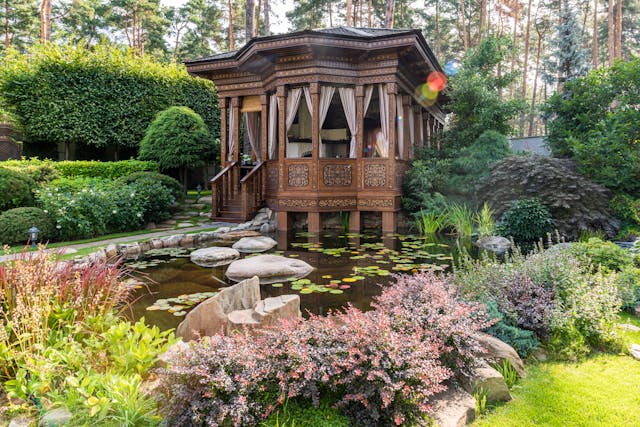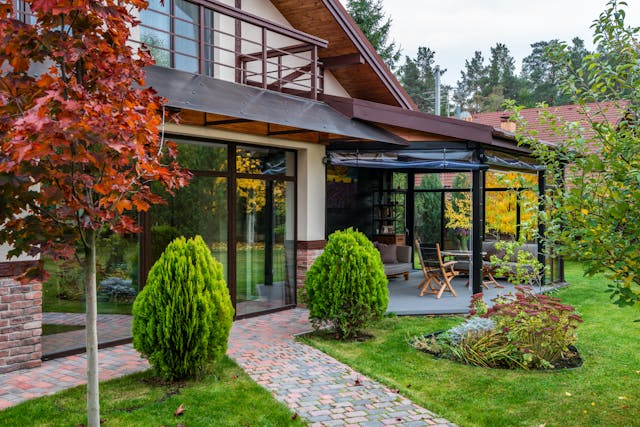There is a certain kind of sophisticated minimalism that defies simplicity. It may be found in the glaze of Edmund de Waal’s porcelain pots, in the cut of a cashmere sweater from Loro Piana, and in the gardens created by Luciano Giubbilei, our Garden Designer of the Year for 2024. Despite being born in Siena, Luciano has spent the last thirty years living and working in London. These days, he mostly works on large-scale projects in rural areas. However, he continues to emphasize proportion and harmony in an Italianate manner, which is particularly noticeable in the smaller city garden designs he creates.

This little verdant garden in west London, designed by Luciano three years ago, is a superb example of his talent. “It was a basic area next to a shared garden,” he says. “However, every component had to work together harmoniously: the sculpture’s placement, the height of the tree canopy, the foliage’s tapestry, and the connection between the garden and the house’s interior.”
Working together on the project was interior designer Steven Volpe, whose San Francisco company is renowned for creating subtly sensual and elegant designs and who, like Luciano, is recognized for artfully outfitting rooms. At the center of the planting in this garden is a sculpture by Barbara Hepworth called Youth, which is part of her The Family of Man series. It also serves as a focal point when seen from inside the home.
“We gave the vignette’s framing from the house’s perspective just as much thought as we did to the experience of strolling through the garden,” explains Luciano. The location really brings the sculpture to life, yet the sculpture itself is the main attraction. The focal point of this garden is the plants themselves, their shapes and leaves, and that special time of year in spring when foxgloves are in full bloom.
He goes on, “I think it is important to be surrounded by plants, especially in a city garden.” In this instance, the lines are blurred to provide for a feeling of exploration and discovery. Together, Luciano and plant experts Chris and Toby Marchant created a planting design that gives this little area an amazing feeling of depth. The contrast between volume and height, as well as between airy and substantial, creates a balance that confuses the sight and stimulates the senses. And there’s still enough for an outside kitchen and three distinct sitting places.
The private garden and the public green space beyond are connected by a massive hornbeam that was forced to be craned in over the house. Luciano has strategically placed a peculiar piece of yew topiary to hide the narrow doorway that separates the two. A magnificent Cornus kousa, covered in a mass of creamy bracts in early summer, and an attractively matched pair of multi-stemmed acers, routinely trimmed to ensure their proportions are never less than optimal, are also present, as is a second organic yew mound next to the home. A permanent thick, shrubby framework is created by abundant mounds of honey-scented Euphorbia mellifera and masses of oak-leaved Hydrangea quercifolia. Below, the understorey planting creates an ephemeral tapestry of delicate shade-tolerant plants. While most are chosen mostly for their foliage, several also have noteworthy seasonal features.
Clusters of lime-green bells, delicately tinged with maroon, enliven the dreary days of January on Helleborus foetidus, a plant with beautifully dissected leaves. Then, small white-horned violets appear with the arrival of spring, along with a haze of cow parsley and Gillenia trifoliata, which blooms brilliantly from May to August. In late summer, Eurybia divaricata and white Anemone x hybrida ‘Honorine Jobert’ take over, while Hakonechloa macra, an ornamental grass, changes from a vibrant green to a gentle brown as fall approaches.

Each cultivar has been chosen with care. The peachy orange blossoms of Epimedium x warleyense ‘Ellen Willmott’ mirror the golden hairs on the golden tassel fern Polystichum polyblepharum. The warm tones of the brick pavers that flow from the house’s interior into the garden are echoed by these. Upon closer inspection, it becomes evident that every aspect of this garden, even the three wood boards that comprise the garden tabletop and the subtle downlighting of the Hepworth sculpture, has been well thought out. The end effect is a calm haven in the middle of the metropolis. “There’s a calm vibe,” Luciano remarks. It is a welcome change of pace.
